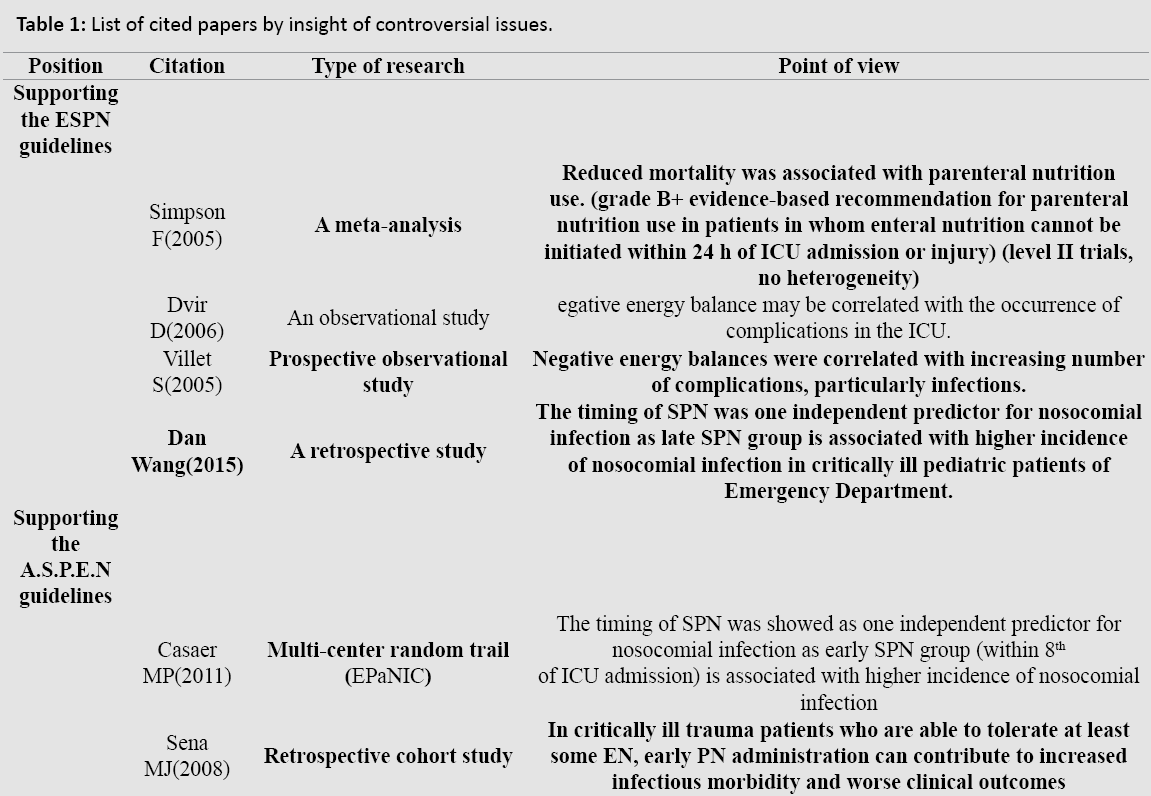Research Article - (2015) Volume 23, Issue 6
School of Medical Management and Health Management, Tongji Medical College of Huazhong University of Science and Technology ,Wuhan, PR China
Xiaoquan Lai MD
Tongji Hospital, Tongji Medical College of Huazhong University of Science and Technology, Wuhan, PR China
Chenxi Liu MM
School of Medical Management and Health Management, Tongji Medical College of Huazhong University of Science and Technology ,Wuhan, PR China
Yuqi Xiong MM
School of Medical Management and Health Management, Tongji Medical College of Huazhong University of Science and Technology ,Wuhan, PR China
Xinping Zhang MD*
School of Medical Management and Health Management, Tongji Medical College of Huazhong University of Science and Technology ,Wuhan, PR China
The controversial issues from guidelines and their support exist on optimal timing for the initiation of supplemental parenteral nutrition in critical conditions. The reason of the controversial such as different study population, caloric quantity, study designs and etc is complex which needed further research.
Supplemental parenteral nutrition; Timing; Critically ill patients.
Nutritional support for patients in the intensive-care unit (ICU) is part of standard care.[1-2] Both enteral nutrition (EN) and parenteral nutrition (PN) route have restrictions. The previous studies have shown that EN alone often cannot achieve caloric targets while PN alone results in increased infectious complications.[3-4] Such challenge prompts the exploring about supplemental PN approach (SPN) (EN combined with PN when EN alone is insufficient) which had validated SPN as one effective way to reduce nosocomial infection when initiated at 4 days after admission in critically ill adults.[5] The delivering timing for SPN has become one big concern for nutrition research field. This article encompasses the main findings concerning timing of SPN in critically ill patients.
Based on current clinical guidelines and substantial evidence, the consensus that early EN should be initiated within 48 hours of admission when the gastro-intestinal tract is functioning has been reached. [6-9] However, optimal timing for the initiation of PN still remains controversial.[10]The European (ESPEN) and American (A.S.P.E.N.) guidelines have put forth conflicting recommendations about the timing of PN initiation.[11-12] ESPEN recommended patients who are not expected to be on normal nutrition within 2-3 d should receive PN within 24 to 48 h if EN is contraindicated, while A.S.P.E.N. supported no SPN should be provided if early EN is not feasible or is unavailable during the first 7d.
Supporting the guidelines for ESPN, a meta analysis of Simpson F showed that the early initiation of PN increased the survival of critically ill patients compared with patients who received EN late.[9] Also, the researches of Dvir D and Villet S showed that early SPN with quicker restoration process was associated with lower percentage of nosocomial infection. In our study conducted in pediatric patients in PICU of Emergency Department, the timing of SPN was showed as one independent predictor for nosocomial infection as late SPN group (48th after PICU admission) is associated with higher incidence of nosocomial infection. Similar to the guidelines of A.S.P.E.N., a multi-center randomized trial conducted later supported the initiation of SPN after 8th day of admission (EPaNIC).[13]Similarly, the study conducted in critically ill trauma patients showed SPN initiated in within 7 days after injury was associated with increased infectious complications.[14]Thus the timing of SPN is still under debate demanding for further studies.(Table 1)

Why the controversial issues exist?
The disagreement between researches was likely due to the following factors as discussed in detail. Firstly, study population is likely one important factor. Study population supporting different positions were different, such as the pediatric or adult patients, medical or surgical conditions. The difference between groups for nutritional delivery and energy requirements cannot be ignored as one possible factor for nosocomial infection. For example, In the EPaNIC study, the specific amount of nutrition was designed and delivered in early-initiation and late -initiation group following the study protocol, as the nutrition amount delivered in this study was followed by the Chinese guidelines for all pediatric patients[15]. As for the nutrition requirement for both studies, calculations regarding the caloric goal included protein energy and were based on corrected ideal body weight, age, and sex in the multi-center study, while the WHO equation[16] was applied for pediatric patients. Further study controlling the effect of nutrition delivery and requirement need be done for exploring the response of different study population to nosocomial infection. Another factor for our observation includes difference in caloric quantity. Due to the discrepancy of study designs, the feeding strategy was designed with the dose targeted to a certain value in random controlled studies while patients in retrospective study groups received varied nutrition amounts prescription as the nutritional practice demanded. It is not certain exactly how an increased number of calories might influence nosocomial infection, regardless of the composition of nutrition support.
The issues on optimal timing for the initiation of parenteral nutrition in critical conditions existed universal controversial from guidelines to research evidence. The reason of the controversial is complex which needed further research.
Further studies can be conducted exploring the optimal timing for SPN approach after controlling the aforementioned confounding factors. Initially, the issues raised by heterogeneous study population need to be controlled, such as the nutrition demand. Also, prospective studies need to be designed with exact feeding strategy for nutrition delivery amounts. Thus prospective comparative study would be become one direction for further research.